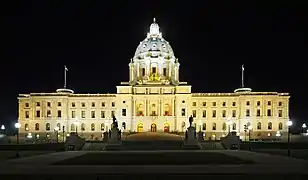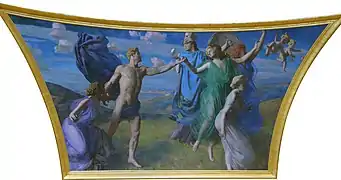Minnesota State Capitol
The Minnesota State Capitol is the seat of government for the U.S. state of Minnesota, in its capital city of Saint Paul. It houses the Minnesota Senate, Minnesota House of Representatives, the office of the Attorney General and the office of the Governor. The building also includes a chamber for the Minnesota Supreme Court, although court activities usually take place in the neighboring Minnesota Judicial Center.
Minnesota State capitol building | |
 The Minnesota State Capitol from the south | |
  | |
| Location | 75 Rev. Martin Luther King Jr Boulevard, Saint Paul, Minnesota |
|---|---|
| Coordinates | 44°57′19″N 93°6′8″W |
| Built | 1905 |
| Architect | Cass Gilbert |
| Architectural style | Italian Renaissance, Beaux-Arts |
| NRHP reference No. | 72000681 [1] |
| Added to NRHP | February 23, 1972 |
The building is set in a landscaped campus. Various monuments are to its sides and front. Behind, a bridge spans University Avenue, and in front others were later added over the sunken roadway of Interstate 94, thus preserving the sight lines. Set near the crest of a hill, from the Capitol steps a panoramic view of downtown Saint Paul is presented.
East to west, the Capitol is more than 430 feet long. From ground level to the top of the dome's lantern measures 220 feet. Inside, the building has more than 300,000 square feet of floor space, or about 5 million cubic feet of space.[2]
History

First Minnesota State Capitol
The current state capitol building is actually the third building to serve this purpose. The first state capitol building was completed in 1853 and served as the seat of Minnesota's territorial and early state government until it burned in 1881. The legislature moved into the new capitol in time for the 5th territorial legislative session on January 4, 1854. The capitol expanded with a new wing on the Exchange Street side of the building in 1873 and a second wing facing Wabasha Street in 1878. It was destroyed by fire in 1881. It was replaced on the same site in 1883 with a four-story, Romanesque, masonry building designed by Leroy Buffington. Shortly after it was opened, was recognized as being too small almost immediately and suffered from poor ventilation. [3]
Second Minnesota State Capitol
After fire destroyed Minnesota's first capitol building on March 1, 1881, the second capitol, completed in 1883, served as the seat of Minnesota state government for just 10 years before state officials began planning a grander, more efficient capitol. The second capitol building stood on the site of the first capitol for 55 years until its demolition in 1937. [4]
Third Minnesota State Capitol
The present state capitol was designed by Cass Gilbert with Butler-Ryan Construction as the contractor. Work began on the capitol in 1896, its corner-stone laid July 27, 1898, and construction was completed in 1905. The capitol cost US$4.5 million at the beginning of the 20th century. It opened its doors to the public for the first time on January 2, 1905. A hundred years later, the building's estimated value was $400 million. Upon completion, the building drew praise, leading to requests for Gilbert to design capitol buildings for other states such as West Virginia and Arkansas and other notable structures.[5][2]
Workers building the Minnesota State Capitol
Construction of the Capitol began in 1896, employing hundreds of workers. The names of the Capitol Commissioners, and the architect Cass Gilbert and his associates, were cast onto a bronze plate.[6] Six workers were killed in accidents during the building of the Minnesota State Capitol between 1898 and 1903, the result of unsafe working conditions.[7]
Quadriga

Above the southern entrance to the building is a gilded quadriga called The Progress of the State which was sculpted by Daniel Chester French and Edward Clark Potter. It was completed and raised to the roof of the capitol in 1906. The four horses represent the power of nature: earth, wind, fire and water. The women leading the horses symbolize civilization, and the man on the chariot represents prosperity.[8] The sculpture group underwent regilding in 1949 and again in 1979. In 1994 and 1995, the statues underwent a restoration procedure which included replacing the gold leaf on the figures. The year-long restoration involved replacing the corroded steel supports inside each statue. The golden sphere perched on the lantern above the capitol dome had similar treatment.
In 2014 the figure of the charioteer was removed and lowered to the ground to allow repairs to corrosion to the top surface of the chariot and was reinstalled in 2015.[9][10]
Dome

2. Middle brick and steel dome
3. Inner plaster dome.
Minnesota's State Capitol dome is the second largest self-supported marble dome in the world, behind Saint Peter's Basilica in Rome of which Gilbert based the design of his dome on. The dome itself is actually made up of three domes or layers. The outer layer is a self-supporting dome made of Georgia marble blocks resting upon their own weight. Hidden inside is a brick and steel cone that supports the lantern and golden sphere at the top of the dome and provides an internal water drainage system. Below that is the decorative masonry dome that can be seen from the inside, looking up from the rotunda.[5][2]
Stone
Being just over 30 years after the American Civil War, Gilbert drew ire for choosing marble from Georgia rather than native Minnesota granite. Gilbert insisted on using Georgia white marble, saying that the use of a darker color would make it look "glooming and forbidding." A compromise was made with native granite and limestone for steps, base and interior walls of Kasota stone and the rare Minnesota Pipestone used by Native Americans for their peace pipes, while using the Georgia white marble for the vast majority of the buildings’ exterior.[5][2]
Other

Most days of the week the building is open for individual visits, guided tours are given free of charge by professional docents from the Minnesota Historical Society hourly and last about 45 mins.[11] Upon entering the building by the south door, one is below the central dome. A large star, symbolizing Minnesota's motto, "The Star of the North", is directly beneath the apex. Various portraits of state governors, and flags captured by Minnesota's regiments during the American Civil War, are on display. Paintings showing some of the related battles can be seen in the governor's outer office.
The structure was added to the National Register of Historic Places in 1972.
Renovation

The Minnesota State Capitol underwent a comprehensive restoration project from 2013 to 2017, the first major renovation since the building first opened.[12] Work began in 2013, with the project estimated at that time to cost $241 million, funded via a series of appropriations made by the Minnesota legislature.[13] The project repaired and modernized deteriorating building systems, restored the building to Cass Gilbert's original architectural vision, increased public meeting space (including a new classroom for the Minnesota Historical Society to host school groups and provide information about the building), updated life safety systems and improved accessibility for people with disabilities.[14]
During renovation, more than 30,000 pieces of marble were restored or replaced.[15] The amount of public space in the building was doubled to nearly 40,000 square feet, with a number of new public spaces opened to the public for reservation and use year round.[16]
The project also included a restoration of the capitol's many works of fine art, which prompted discussions over some paintings in the building that feature controversial depictions of American Indians. A series of public input meetings were held around the state to gather feedback and consider options for new policies regarding art in the renovated building.[17] When the building reopened, two of these paintings, Father Hennepin Discovering the Falls of St. Anthony, and the Treaty of Traverse des Sioux were relocated while others remained in place.[18]
The renovation forced the House and Senate to hold a special session in the nearby State Office Building in 2015. During the regular 2016 session, the Senate met in the newly completed Senate Office Building, with the capitol open for only limited access to the House chamber during the session.[19]
By the time of its completion in 2017, the total cost of the renovation project reached about $310 million.[20] The bulk of construction was completed by the start of the 2017 legislative session in January.[21] The project was officially completed in August 2017, at which point all of the building's newly renovated spaces opened to the public.[22]
A three-day grand opening celebration took place on August 11, 12, and 13, 2017.[23][24] The grand opening celebration featured a ribbon cutting ceremony with state and local leaders, panel conversations with notable Minnesotans (including former U.S. Vice President Walter Mondale and Minnesota Lynx Head Coach Cheryl Reeve), a beer tasting event with more than 25 Minnesota craft brewers, and musical performances from Minnesota bands Poliça and Cloud Cult.[25]
Minnesota State Capitol Mall
The State Capitol Mall includes eighteen acres of green space. Over the years, monuments, and memorials, have been added to the mall. The mall and the capitol building itself are overseen by the Capitol Area Architectural and Planning Board (CAAPB), a small state agency consisting of twelve members, with responsibilities to preserve and enhance the dignity, beauty, and architectural integrity of the capitol, the buildings adjacent to it, the capitol grounds, and the capitol area.[26]
Galleries
 The Capitol at night
The Capitol at night Marble dome
Marble dome The Progress of the State (Quadriga)
The Progress of the State (Quadriga) Inside the dome
Inside the dome.jpg.webp) Rotunda
Rotunda.jpg.webp) Interior hallway
Interior hallway Supreme Court chamber
Supreme Court chamber House of Representatives chamber
House of Representatives chamber State Senate chamber
State Senate chamber.jpg.webp) West Wing leading to the Senate chamber
West Wing leading to the Senate chamber East Wing leading to the Supreme Court Chamber
East Wing leading to the Supreme Court Chamber
Paintings in Governor’s Reception Room and Anteroom
 The Battle of Gettysburg by Fairchild Zogbaum
The Battle of Gettysburg by Fairchild Zogbaum The Second Minnesota Regiment at Missionary Ridge, by Douglas Volk
The Second Minnesota Regiment at Missionary Ridge, by Douglas Volk The Fourth Minnesota Entering Vicksburg, by Francis D. Millet
The Fourth Minnesota Entering Vicksburg, by Francis D. Millet The Fifth Minnesota at Corinth, by Edwin H. Blashfield
The Fifth Minnesota at Corinth, by Edwin H. Blashfield The Battle of Nashville, by Howard Pyle
The Battle of Nashville, by Howard Pyle The Third Minnesota Entering Little Rock by Stanley M. Arthurs
The Third Minnesota Entering Little Rock by Stanley M. Arthurs
Memorials in the rotunda
 William J. Colvill Memorial
William J. Colvill Memorial James Shields Memorial
James Shields Memorial John B. Sanborn Memorial
John B. Sanborn Memorial Alexander Wilkin Memorial
Alexander Wilkin Memorial
"Civilization of the Northwest" murals on the rotunda
 Rotunda (Southeast Corner)
Rotunda (Southeast Corner) Rotunda (Southwest Corner)
Rotunda (Southwest Corner) Rotunda (Northwest Corner)
Rotunda (Northwest Corner) Rotunda (Northeast Corner)
Rotunda (Northeast Corner)
References
- "National Register Information System". National Register of Historic Places. National Park Service. March 15, 2006.
- "Architecture". Minnesota Historical Society. Retrieved 2021-01-29.
- Cameron, Linda A. (September 6, 2017). "Minnesota's First State Capitol". MNOpedia. Retrieved 2021-02-02.
- Cameron, Linda A. (February 27, 2018). "Minnesota's Second State Capitol". MNOpedia. Retrieved 2021-02-03.
 Material was copied from this source, which is available under a Creative Commons Attribution 4.0 International License.
Material was copied from this source, which is available under a Creative Commons Attribution 4.0 International License. - "The Minnesota State Capitol Building". Capitol Area Architectural and Planning Board. Retrieved 2021-01-29.
- "Who Built Our Capitol?". Who Built Our Capitol?. Labor Education Service, University of Minnesota. 2017. Retrieved 2021-02-03.
- Croce, Randy (August 21, 2019). "Workers Killed During State Capitol Construction, 1898–1903". MNOpedia. Retrieved 2021-02-02.
- "Progress of the State (Quadriga)". Minnesota Historical Society. Retrieved 26 October 2018.
- Salisbury, Bill (September 23, 2014). "State Capitol temporarily loses charioteer of the golden Quadriga". Pioneer Press. Retrieved 2021-01-29.
- Cameron, Linda (March 3, 2019). "Quadriga: "The Progress of the State"". MNOpedia. Retrieved 2021-01-29.
- https://www.mnhs.org/capitol. Missing or empty
|title=(help) - "The Minnesota State Capitol restoration project, explained". Retrieved 4 April 2017.
- "Minnesota Capitol: It's crumbling, but what a price tag". Retrieved 1 October 2017.
- "Minnesota State Capitol Restoration Project – Guiding Principles". Retrieved 1 October 2017.
- "Restoring the Glory: A balancing act for architects on Capitol restoration". Retrieved 1 October 2017.
- "Minnesota State Capitol Grand Opening Celebration – About the Restoration". Retrieved 1 October 2017.
- "Minnesota State Capitol Restoration Project – Art Subcommittee". Retrieved 1 October 2017.
- "Bitter fight over controversial Capitol art finally ends". Retrieved 1 October 2017.
- "After controversy, new Minnesota Senate Office Building finally opens – Twin Cities". Retrieved 4 April 2017.
- "Minnesota State Capitol Grand Opening Celebration – About the Restoration". Retrieved 1 October 2017.
- TEGNA. "First look: Minnesota's renovated capitol". Retrieved 4 April 2017.
- "Restored Minnesota State Capitol re-opens to the public". Retrieved 1 October 2017.
- Fitzgerald, Kilat (August 14, 2017). "Minnesota state capitol celebrates grand opening after restoration". La Crosse Tribune. Retrieved 2017-09-08.
- West, Tom (August 19, 2017). "Notes from a visit to our restored State Capitol". dairylandpeach.com. Retrieved 2017-09-08.
- "Minnesota State Capitol Grand Opening Celebration – Events Schedule". Retrieved 1 October 2017.
- "About Us". Capitol Area Architectural and Planning Board. Retrieved 2021-01-28.
- Elmer L. Andersen. Elmer's Tour: A Former Governor's Loving Look at the Minnesota State Capitol. Nodin Press, 2005. ISBN 1-932472-38-X
External links
| Wikimedia Commons has media related to Minnesota State Capitol. |
- Minnesota State Capitol – Minnesota Department of Administration
- State Capitol Restoration Project – Minnesota Department of Administration
- Minnesota State Capitol Preservation Commission
- Minnesota Historical Society State Capitol webpage
- Gilbert sketch for the project

